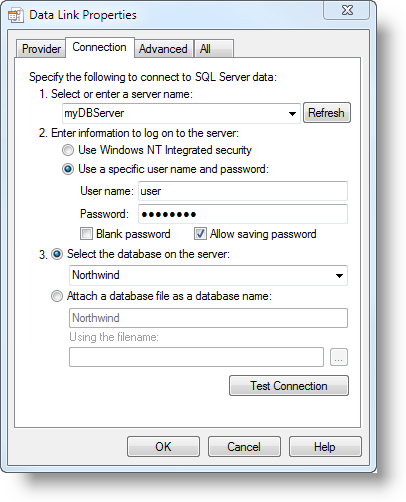Using Generic Connections and Connection Strings
Another method of creating a connection is to use one of the generic Connection elements, which requires that you provide a connection string.

In the example shown above, a Connection.OLEDB element has been added to the _Settings definition. Its Connection String attribute has been configured with a connection string, which looks like this in its entirety:
- Provider=SQLOLEDB.1;Password=password;Persist Security Info=True;User ID=user;Initial Catalog=Northwind;Data Source=myDBServer
You can see that the connection string has a specific format, which is unique to the connection type. The Connection.OLEDB element can invoke a special wizard to build its connection string; for all other connections, developers will need to provide an appropriate string.

The Data Link Properties wizard, shown above, assists in the creation of connection strings for the Connection.OLEDB element. In Studio, click the little browse button at the end of the element's Connection String attribute value to invoke the wizard. The Test Connection button only ensures network connectivity to the database server - it does not guarantee that the User Name and Password entered are valid! The test can be successful and yet you may still not be able to access the data if the credentials are wrong. If providing specific credentials, be sure that you enter them carefully and check Allow saving password.
This very useful web site: http://www.ConnectionStrings.com provides example connection strings for a wide variety of datasources and can assist in providing the proper format for strings for other connection types.
With ActiveSQL
If Connection.JDBC or Connection.ODBC is used with DataLayer.ActiveSQL, you must configure the Connection element's optional SQL Syntax attribute to identify the database's SQL syntax version.
Notes For Java Developers
When using a Connection.JDBC element, specifying an IP address instead of a host name in the connection string may significantly increase the connection opening time, due to the underlying Java implementation. Therefore, it is recommended that developers use host names, not IP addresses, in connection strings to minimize the time it takes to open a connection.
The Connection.SMTP element supports TLS/SSL authentication in Java applications only. This allows connection to Gmail and other similar services that will programmatically send email on your behalf. Set the element's SMTP Authentication Mode attribute to 3 to select TLS/SSL. In v12.2-SP4+, the TLS 1.1 and 1.2 protocols are supported.